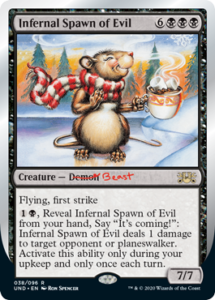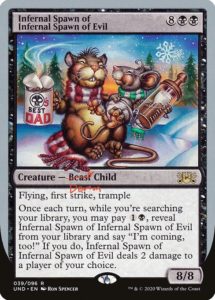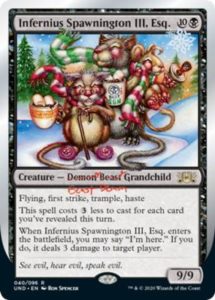“It is not the thing you fear that you must deal with, it is the mother of the thing you fear. The very thing that has given birth to the nightmare.” —David Whyte, The Heart Aroused
It wasn’t Grendel who put up the biggest fight; it was his mother, nothing left to lose with her son in his grave. It’s not the horror you have to deal with, but the structural circumstances that allowed the horror to be not just plausible, but destined. Horror is generational—the trauma is passed down like an heirloom, soaked into the weft of your genes. We can’t just fear the progenitor, or the spawn, but the spawn of the spawn, and so on.
I wept when the 2016 election results came in, because I knew we weren’t dealing with four or eight years, but twenty or thirty or eternity. I knew that night, drunk on Canadian porter and drained of hope, that Trump was the symptom of something larger, and that the reverberations would echo through my entire life. I wept this week when it became clear that we’d passed some silent threshold, that COVID-19 wasn’t just a single pandemic, but a test run for future crises—and a test that my country was failing to even understand, let alone deal with. Fearing a monster isn’t enough: you have to fear what gave birth to it, and what it will birth in turn. Monsters, by the way, always breed.
We see that in the Titans from Greek myth—as in Theros, they led to the gods, who fused gargantuan powers with moral foibles, giving us the worst of both worlds. We also see it born out in the three generations of one of the Blackest cards of all time: Infernal Spawn of Evil and his progeny and grandprogeny. The three Infernals tell a story—not just a single narrative, but a multigenerational epic, something that only becomes coherent once you’ve met the thing and its mother. It’s not exactly The House of the Spirits or East of Eden, but it has that same core narrative that made Dominaria so appealing, the sense of homecoming and of continuity.

Like most of Unglued, Infernal Spawn of Evil was metareferential—it references the Satanic Panic-fueled re-envisioning of Magic’s Demons into Horrors or Beasts in the card’s creature type. Plus its casting cost is a callback to Spirit of the Night, the original Griselbrand. Mark Rosewater has stated that it’s his favorite card from Unglued, partially because it let him use the slush art Ron Spencer turned in as a joke circa Tempest; and partially because it led to future designs, like Dissension’s Forecast and Rivals of Ixalan’s Tetzimoc. First printed in 1998 when I was eleven, when the world was paradoxically bigger and smaller, and full of both immutable order and omnipresent monsters.
Now reprinted in 2020, the only change is that it can deal damage to Planeswalkers, and the great interaction he has with Rings a Bell. I’ve been drawn to pair the black mini-deck from the Unsanctioned set with the blue for precisely that reason. Aside from that, he’s your basic Spirit of the Night/Akroma, Angel of Wrath keyword gumbo reanimation target.

Infernal Spawn of Infernal Spawn of Evil dates back to 2004’s Unhinged, and set the pattern for the family with +1 mana for +1/+1 and an additional keyword. Oddly, it has never received the Planeswalker update text—it can only do damage to players themselves, and doesn’t target to do so. It was rare that you’d search your library back in Unhinged Limited—mostly, you’d only be able to use his ability via Land Grant or “Ach, Hans, Run!” so it’s essentially flavor text.

Finally, in Unsanctioned earlier this month, we got the third and presumably final member of the family tree in Infernius Spawnington III, Esq. (so presumably, we can assume that I.S.o.E. and I.S.o.I.S.o.E. are both named Infernius Spawnington). I don’t love the naming of Trip here—for one thing, he’s a child, so I highly doubt he has his J.D. But I love what he represents: the culmination of the Spawn trio, a continuation of the one mana for +1/+1 and another keyword trend, and another zone from which to deal damage. In this case, it’s a simple enters-the-battlefield ability, so Panharmonicon lets you double up, and he can combine with cards that force a reveal beyond his predecessors.
He’s pretty great with Aesthetic Consultation or Augment cards if you’re playing silver-bordered cardsets, and he’s pretty superb with Blessed Reincarnation, Blood Speaker, Treasure Keeper, Jace, Architect of Thought, or Nightshade Seer. (The secret combo of Infernius Spawnington III, Esq. and Squirrel Farm has been my favorite part of Unsanctioned—you can reveal it three times to Squirrel Farm for 3GGG to reduce his casting cost to 1B. Sure, it only saves you three mana, but it sends a hell of a message.)
Infernius stands out for one reason as unique as it is opaque: his damage ability is tied to a simple declarative, rather than an exclamation. “I’m here.” is different from “I’m coming!,” and it suggests a statement of fact, rather than a promise. Jack Nicholson breaking through a door to state “Here’s Johnny,” just doesn’t land quite as intensely. I’m not sure why he breaks tradition this way, but that’s not the only oddly dissonant part of the Infernal Spawn trio.
Bucking the Whyte quote, the Infernal dynasty gets more powerful as they get younger, ramping up from 7/7 to 8/8 to 9/9. I read this, because of the person I am, as a statement of generational privilege and wealth. The more you have, the more you can hand down to your children, until the weight of their wealth increases their momentum. Infernal Spawn of Evil does one damage from hand, zero damage the turn you play it, and seven damage the next turn. Infernal Spawn of Infernal Spawn does two damage from the library, zero damage the turn you play it, and eight the following turn. Meanwhile, Trey does three damage from hand, and nine damage the turn you play it. When his grandfather has meted out eight damage, Infernius Spawnington has dealt twenty-one
The Un-sets have progeny of their own. Above all else, Unglued doesn’t get the respect it deserves—in its own way, it was as revolutionary as Battlebond or the Mystery Booster series. Not only did it introduce full-art lands, but it was the first booster set to include tokens. Some of the design elements—watermarks in the text box, frame-breaking art, the “Meld” mechanic presaged by B.F.M., and sideways cards—were brought back in tournament-legal Magic, and the set was a secret test run for radical design.
The canceled follow-up set, Unglued 2, was meant to continue that trend—between the return of poison (including poisoning yourself for a benefit), scratch-off “Legacy game” cards, and full-art cards, the set would have been another exploratory effort. Meanwhile, per Mark Rosewater, Unstable was partially designed specifically to explore new printing technology—only to have to scrap that as they “got a little too ahead of technology.”
Some of that may come to fruition in years to come. I think that Mystery Booster, with its arcane collation pattern and random pairings (I’ve now seen two Sealed decks that include the Teferi’s Puzzle Box plus Zur’s Weirding pseudo-combo) has gotten us a step closer, but the initial plans for Unstable were a moonshot. That’s the legacy so many of us leave behind: we got a little too ahead, and we leave it to our children and grandchildren to pick up the pieces.
A lifelong resident of the Carolinas and a graduate of the University of North Carolina, Rob has played Magic since he picked a Darkling Stalker up off the soccer field at summer camp. He works for nonprofits as an educational strategies developer and, in his off-hours, enjoys writing fiction, playing games, and exploring new beers.

